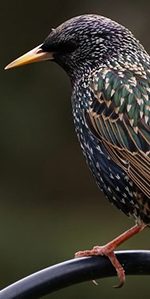| European Starling | ||
 |
Classification(s) : | Prey |
| Cat Name : | Crow | |
| Common Name : | European Starling | |
| Scientific Name : | Sturnus vulgaris | |
| Other Name(s) : | ||
| Physical Description : | A European Starling’s feathers are black, glossed purple or green and spotted with white. Young Starlings are grey-brown. The legs are short and pinkish-red. In summer the male’s beak is yellow with a blue-gray base, the female’s beak is yellow. In winter, the beak is black. The feathers have white tips. Their foot is star-shaped. |
|
| Physical Statistics : | Length: 7 – 9 Inches (19 – 22 Centimeters) |
|
| Behavior : | European Starlings usually live in grasslands and open woodland. They are active during the day, flying to the ground where they eat seeds and insects. |
|
| Social Organization : | Flock; European Starlings live in sizable groups. |
|
| Approval Level : | None; European Starlings are very common in the forest. | |
| Kill Difficulty : | Moderate; European Starlings have sharp talons and beaks in addition to running in large groups. |
|
| Training Level : | Specialty - Group Flying; The bulk of the flock must be kept busy while stragglers are caught and killed. |
|
| Hunting Tactic : | Birds | |
| Food Quality : | High; Starlings are a decently sized catch that yields tasty flesh of good quality. | |
